Natalie Hume is a PhD candidate at the Courtauld Institute of Art. Her thesis, ‘The Graphic Representation of America in Britain, 1865–1880’ is undertaken as part of Scrambled Messages – the Telegraphic Imaginary 1857–1900, an intercollegiate research project with Kings College London and the Institute of Making, UCL. Natalie will be speaking at the Woodpeckings conference, on 16-17 June.
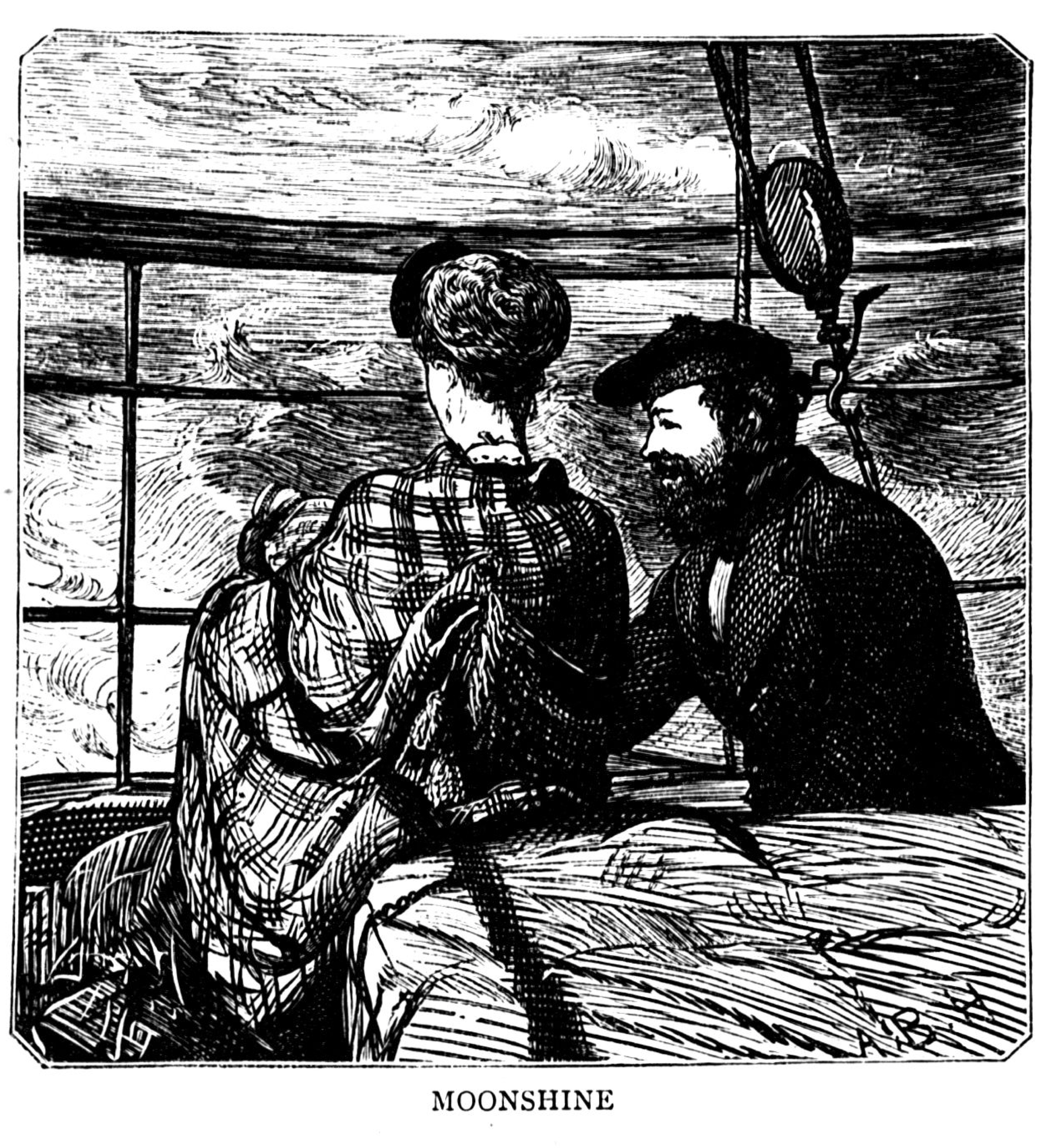
Through the Looking-Glass, and What Alice Found There, published in 1871, was a sequel to the fantastically successful Alice’s Adventures in Wonderland. That year is a key one for my own research, which explores British artists’ portrayals of America: following the completion of the transcontinental railroad in 1869, the United States was encouraging tourism both from its own people and from overseas visitors. The British experience of America during this period began with a long steamer journey: a suspension of everyday life in the midst of a great glassy ocean. The transition – the crossing of the ‘pond’ – brought travellers to a kind of looking-glass land, one that was both familiar and strange. As well as transport infrastructure, such travels were facilitated by new communication technologies, including telegraphy, photography and guide books, making the previously remote American West gradually more accessible. The transformations of print media and visual image production would have had particular significance for Charles Dodgson as an author and photographer, as well as for commercial art producers, including illustrators such as John Tenniel and engravers such as the Dalziel brothers.

A pressing investment in medium and technology is embedded in these paradigmatic Alice images, which describe a novel overwhelmingly preoccupied with magical manifestations of binaries, reflections and reversals. The pictures focus on a moment of magical transition, when, according to the Spectator review of the same year, ‘The glass becomes a silvery mist … and she stands in the other room where the clock makes faces at you, and the words in all the books run the wrong way.’[1] Alice’s appearance doesn’t change, yet perspective is everything: from behind, Alice kneels ineffectually on the mantelpiece, as though hysterical, hand flat against the glass; while from the other side she is preternaturally calm, smiling slightly as she moves through the glass. The pair of mirror images appears on the recto and verso of the same page, making the mirror itself concrete, as though Alice is moving through the page itself.
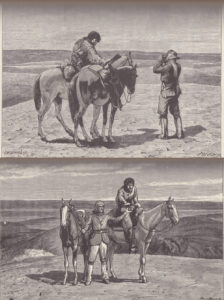
These pictures, which portray reflection and are themselves replete with surfaces and pictures, suggest a self-referential knowingness or multifaceted reflexivity that resonates with Dodgson’s in-jokes, autobiographical associations and games of logic – including, for example, his reversal of literary convention in using an authorial pseudonym while retaining his protagonist’s real-life name.
This pair of illustrations (Fig. 3–4) shows the western plains of the United States, as experienced by the Earl of Dunraven and friend (the artist was another Englishman who travelled with their hunting party). The landscape is dreamlike in its barrenness, and the reader is invited to circle the desolate figures emphasising their vulnerability and insignificance amid the vast emptiness, while the emphasis on field glasses plays on the audience’s awareness of perspective and the act of looking.
In both pairs of pictures, the static closeness between the two perspectives reconfigures the conventional relationship between text and image in illustration. Rather than being a straightforward description of a moment from the text, this is visual narrative proper, foreshadowing early cinema and montage. To subsequent audiences familiar with the moving image, the quality of focused attention imparted by these pairs of images evokes cinematic techniques that do something similar, such as slow-motion or zooming in.
![Figures 5 and 6 [Charles L. Dodgson, photographs of Alice Liddell, c.1858]](http://www.sussex.ac.uk/english/dalziel/wp-content/uploads/2017/04/Natalie-Hume-Carroll-Composite.jpg)
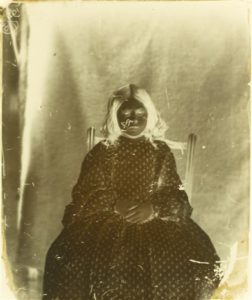
But returning to Alice and the 1870s, the proximity of girl to glass, suggestive of both lens and negative, might allude more directly to Dodgson’s photography of Alice and other young female subjects. Dodgson was an enthusiast of wet-plate processing, which he continued to use after the more convenient dry-plate method became available. The procedure relied on a large glass negative, which had to be processed shortly after exposure.

The large flat surface of the mirror might equally evoke the mysterious surface of the wood block, as Bethan Stevens has suggested in her work on the Dalziel brothers: the block appears flat and blank, but harbours half-hidden images that shimmer in candlelight only to emerge legibly once printed on paper.[2] Wood engraving, like photographic printing, involves reversal, both of colour and composition. Unlike metal engraving the plate is cut in negative, worked in white with the remaining wood contours forming the black lines of the image. The worlds of photography, engraving and looking-glass land are all monochrome: although Alice’s chess set is red and white, the camera saw red as black, while illustrative wood engraving, which had developed as a way to produce images on the same page as printed type, tended to use black ink on white paper.
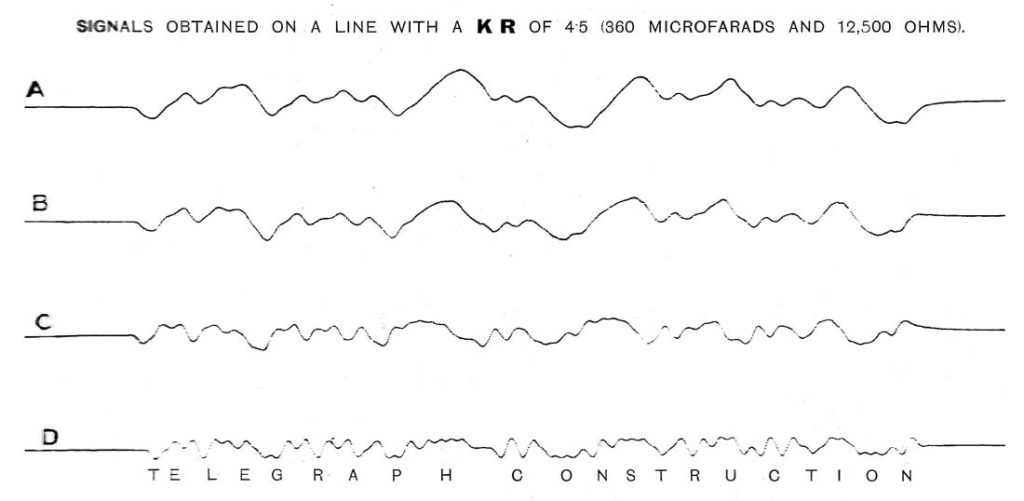
Electrical systems, like photography and engraving, rely on reversals. A current is binary – on or off – but a signal can be reversed to produce a negative signal; this was a principle applied to many telegraphic devices as well as being the basis of alternating current. Capacitance, for example, caused by long cables and heavy insulation, was a particular problem for the transatlantic telegraph cable, and resulted in distorted messages like the signals in line A. One remedy was curb sending, that is, sending a small negative pulse immediately after each positive: this preserved the signal as it travelled the length of the wire, which produces a similar result to the more complicated solution illustrated here in line D.
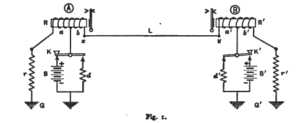
Reverse signalling was equally essential for duplex telegraphy, in which messages could be transmitted and received through a single wire in both directions simultaneously. Each transmitter needed to silence its own sent signals so as not to interfere withmessages from outside, but without affecting the main wire. The installation of a relay or phantom circuit at each end allowed the current transmitted from each end to be automatically matched without affecting the main circuit, so that signals coming from the other end stood out against a local ‘white noise’ effect. The first Tenniel image shows Alice reflected in the mirror: like the answering current, her reflection follows her, the mirror acting as a screen that stops her hand and effectively ‘silences’ her passage through space. In the second, she breaks through the phantom circuit into the main wire, emerging, like a distant message, in looking-glass land.
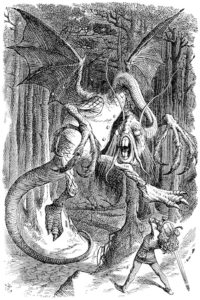
Of course, given the length and location of the transatlantic cable, distortion and interference from a range of sources – including weather, wildlife and human error – was unavoidable. Telegraph workers relied not only on their training in formal code (such as Morse) but also on intuition and common sense: transmitters had to decipher poor handwriting; receivers to interpret garbled or incomplete signals. The Alice texts’ endless, frictionless proliferation of associations and reversals also relies on this kind of intuitive deciphering; the verse of the Jabberwocky, for example, with its neologisms, onomatopoeias and portmanteaus, embodies a kind of scrambled message, intelligible but idiosyncratic.
Such distant telegraphic messages, although they may bear unwelcome traces of the media through which they have passed, nevertheless carry with them a sense of magic and miraculousness. Alice emerges invisible into looking-glass land: she picks up the white king and he is startled to be lifted by an unseen force (see Fig. 12 below). The nature of electricity is still perplexing today: visualising it is problematic, given its instantaneity and physical formlessness. Like Alice running with the red queen, remaining in one spot however fast they go, electricity defies empirical logic (see Fig. 13 below). Like glass and air, it has properties of opacity and transparency: it is neither gas, solid nor liquid, yet it seems to travel. Under the semi-transparent weight of the ocean, the deep cable was not only hidden or invisible but also, because of its vast length and proportion, unimaginable. Like the internet, the cable was solidly physical and grounded geographically, but its function seems to transcend time and space, evoking ethereality and omnipresence.
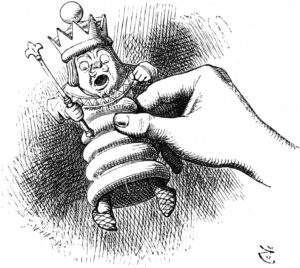
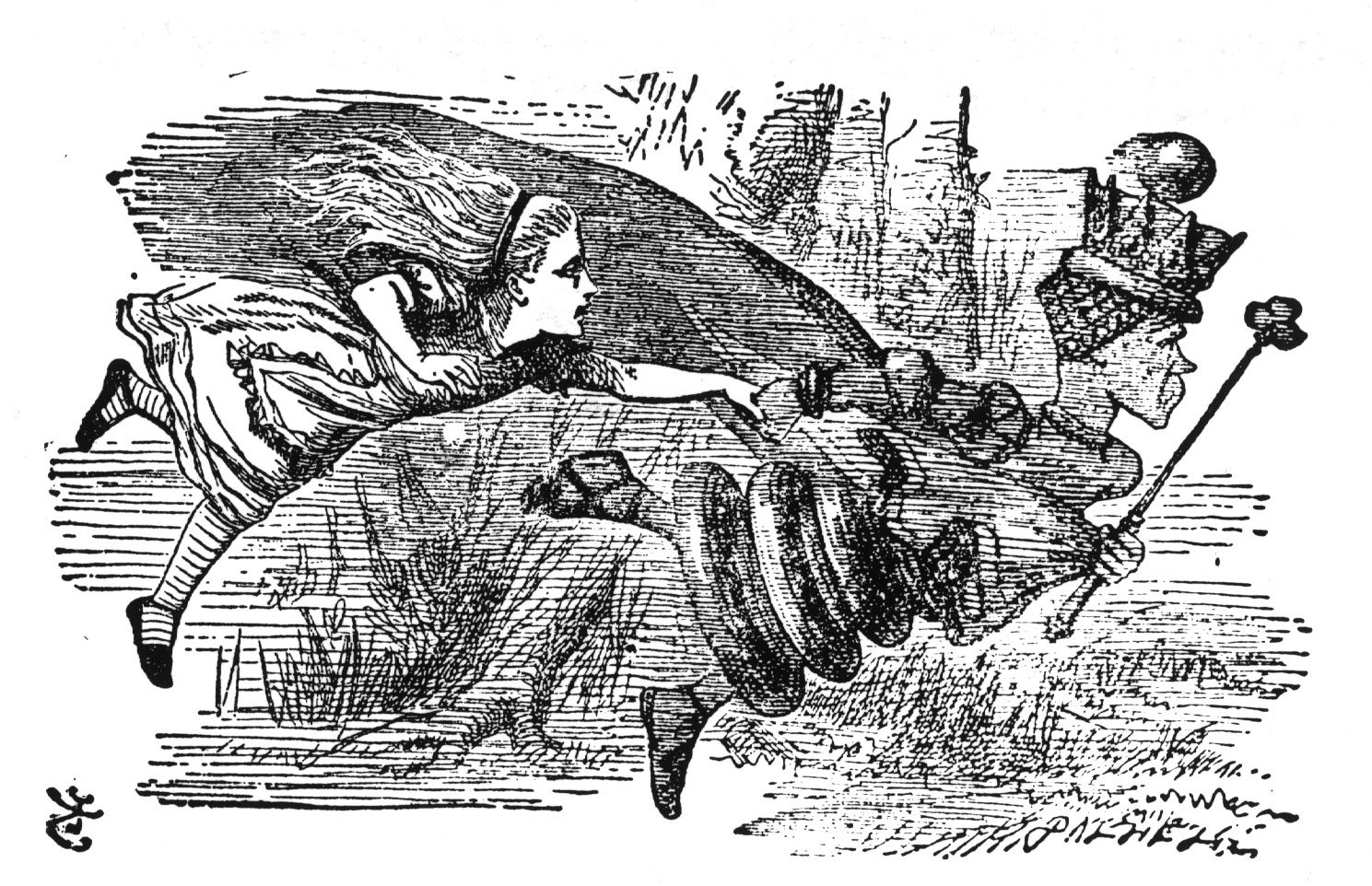

Invisible agency is part of photography’s magic too, the photographer veiled beneath a black cloth to capture the subject, while in the darkroom an absent subject emerges from nowhere. One of Dodgson’s subjects, Ethel Arnold, remembers, ‘Much more exciting than being photographed was being allowed into the dark room, and watch him process the large glass plates. What could be more thrilling than to see the negative gradually take shape, as he gently rocked it to and fro in the acid bath?’ Another, Dymphana Ellis described Dodgson setting up a temporary dark room in the cellar of her family’s country house: ‘I remember the mess and the mystery.… We cried when he went away.’[3] Like the looking-glass, photography has an apparently magical power, defying laws of nature by breaking down barriers between subject and representation, index and imitation, presence and absence.
But just as the opacity of a coded message can emerge into meaning, the flatness of Alice’s mirror dissolves into depth. Isabel Armstrong has written compellingly of the nineteenth-century significance of the properties of glass, proposing that this modern material brought contemporary preoccupations with spirituality, visuality, self-consciousness and desire into dialogue with technology, capital and politics.[4] The prominence of glass, found throughout these two pictures from the mirror to the bell jars to perhaps, invisibly, the glazing on the framed pictures, resonates with the multifaceted signification and significance that Armstrong is claiming for this material. Tenniel’s glass – not quite solid, nor recognisably liquid, nor gas, despite its penetrability – embodies the uncanny magic of everyday technologies and their persistent and layered relationship to the visual practices of Dodgson and the Dalziels. It also stands for transformation, and for the importance of medium – however transparent – both materially and in the thoughts and imagination of those who interact with it.

[1] ‘Through the Looking Glass (book review)’, Spectator, 44 (2270), 30 December 1871, pp. 1607–1609, at p. 1608.
[2] Bethan Stevens, ‘Medium and the Archive (Victorian Wood Engravings, for example)’, BAVS Talks, 10 March 2016, University of Sussex.
[3] From The Letters of Lewis Carroll, ed. Morton Cohen, 2 vols, London: Macmillan, 1979 and Morton Cohen, Lewis Carroll: A Biography, New York: Knopf, 1995, both quoted in Rosella Mallardi, ‘The Photographic Eye and the Vision of Childhood in Lewis Carroll’, Studies in Philology, vol. 107, no. 4, fall 2010, pp. 548–572, at p. 551.
[4] Isobel Armstrong, Victorian Glassworlds: Glass Culture and the Imagination, 1830–1880, Oxford: Oxford University Press, 2008.